This morning, Emma phoned me on her way to the bus stop to point out that the wooden fences along our street were steaming. It had been very wet yesterday but it was comparatively warm and sunny this morning so the fences were warming up.
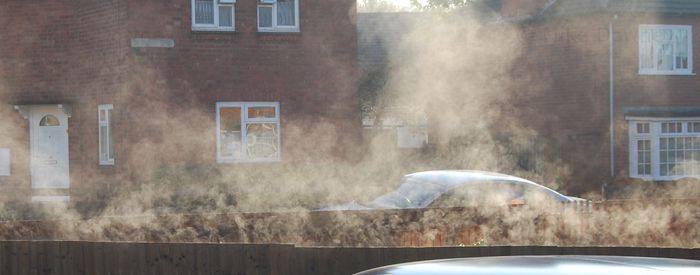
A couple of years ago I tried to grow Butternut Squash and one of the plants did quite well and we got 2 squash off it. This year I haven't had a single squash but the plant has grown huge and taken over half of the garden. It has covered the leeks, carrots and shallots so our crop of those has been very poor too.

The recent warm weather seems to have confused some of the other plants in the garden. I recently cut down one of the pepper plants and the wild strawberry plants but some small green shoots have appeared. I expect the strawberries to do ok over the winter but I will probably have to put the pepper somewhere sheltered to see if it survives the winter to give it a good head start in the spring.
I am still getting tomatoes and chilli peppers from the garden although things are ripening quite slowly now. At least those two crops have been successful this year and I have made roast tomato soup several times, often adding some other veg, such as peppers and courgettes, to the roasting pan.
The Clevedon Hamster Show took place today at St Andrews church hall. While the AGM took place, I took the camera and went for a walk. Apart from the photo of the Ground Squirrel, the photos below were all taken in the town.




Click on the thumbnail to view the image
The London Champs small animal show took place today at its new venue, the East of England Showground in Peterborough. We were there as part of the Hamster Club, as usual. The venue was being shared with the East of England Autumn Show so there were more animals to look at, including sheep, pigs and goats.
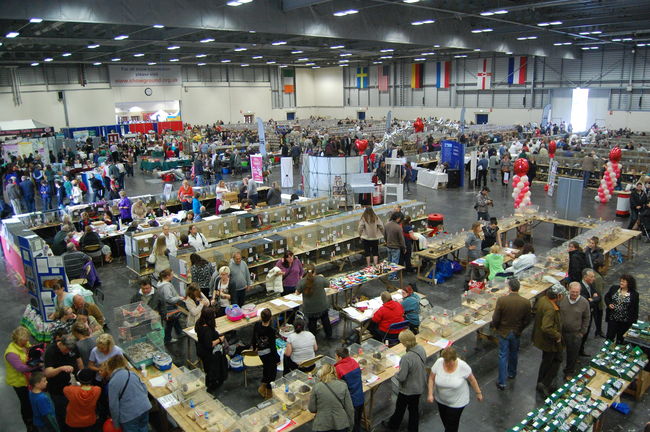

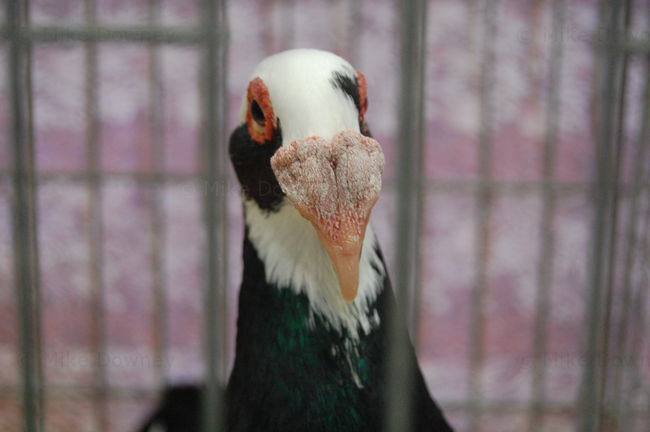
Some of the pigeons on display.
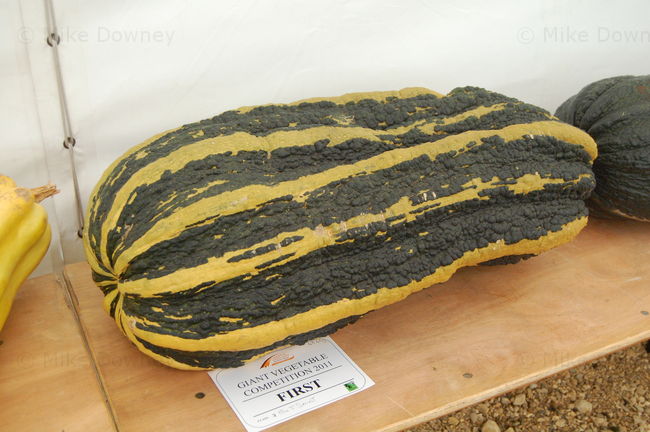
The winner of the marrow section of the Giant Vegetable competition.
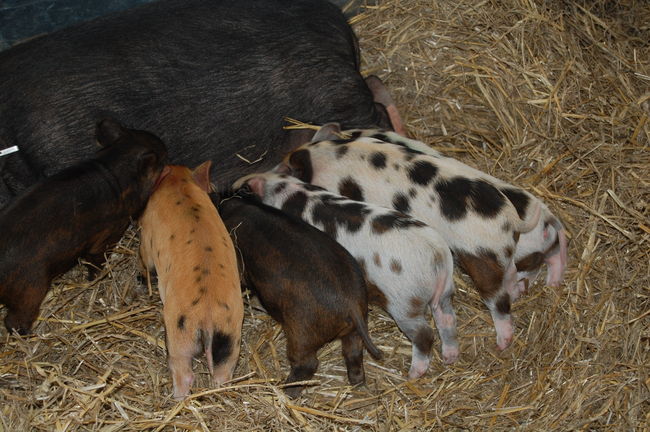
In part 1, I discussed how early life may have arisen. In this part I will comment on one of the aspects of current terrestrial life - that of molecules symmetry or 'handedness'.
Molecular handedness, which chemists call Chirality, is a property of the 4 bonds which a carbon atom can form. If a particular carbon has 4 different groups of atoms attached to it, then there are two ways of attaching them such that one is a mirror image of the other. These are the two chiral forms, which are referred to as D- or L-isomers depending on the particular arrangement. In the 'skeleton' form of the amino acid Leucine, shown below, triangles mean the bond is pointing towards the viewer and the 'ladder' is a bond pointing away.
The centre carbon has the following 4 groups attached to it: Hydrogen NH2 'amine' group CO2H 'carboxylic acid' group CH2CH(CH3)2 branched carbon chain.
In terrestrial life, amino acids are almost exclusively the L-form and sugars are usually the D-form. There have been references to this in science fiction, such as the Arthur C. Clarke short story Technical Error where a scientist accidentally has his molecules changed to the opposite chirality and he is unable to metabolise any food.
If amino acid molecules are created by normal non-biological processes, there is usually a 50:50 mix of the D & L molecules (called a racemic mixture). Somehow, back when life was first beginning, there must have been a selective pressure on one form over the other.
Samples of amino acid have been retrieved from meteorite fragments and these turned out to have an excess of the L-isomer. Experiments have shown that polarized light can produce such a slight excess so conditions may have accidentally selected for a particular isomer and we are left with the legacy of those conditions.
Update (4/11/2011):
Earlier this week there was a discussion on the Simon Mayo show on Radio 2 which was about what would happen if the moon disappeared. This was prompted by a discussion of the film Despicable Me and the sequence where the moon was stolen.
It reminded me of a theory which stated that life wouldn't have developed on Earth if the moon didn't exist. The tides caused by the moon would have stirred up the precursor molecules and hastened any chemical reactions which would have led to life. An alternative version of this theory was presented in Star Trek: The Next Generation, where Q took Captain Picard back to the early Earth. Picard stirred up a 'soup' of organic molecules which mixed together to create life.
This week's science posting is in two parts. Part 1 covers a few theories about how life arose on Earth. Part 2 goes into a bit more detail on the molecules of life.
How Life came to Earth
There are two main theories on how life started on Earth: It came from Outer Space, and it started here on Earth. I will briefly describe the two approaches.
1. Panspermia
This theory claims that life came to Earth from elsewhere in the universe, and that there could be related organisms elsewhere in the galaxy. The approach was popularised by astronomers Fred Hoyle and Chandra Wickramasinghe, who believed that the process was still continuing today and that terrestrial outbreaks of disease could be caused by microbes brought to Earth by comets.
It certainly appears possible that life could be brought to Earth this way. Experiments have taken place where microbes have been taken into orbit and exposed to space where they have been exposed to cosmic rays. This took place in 2008-2010 when a piece of rock was fixed to the outside of the International Space Station. Space is a very harsh environment compared to the surface of the planet: there is no water or oxygen, and no ozone layer or atmosphere to protect against the harsh light from the sun. When the rock was brought back to Earth, laboratory tests showed that the bacteria had survived.
The surface of a comet is fairly hospitable by comparison. There might not be much of an atmosphere most of the time but there is some water and hydrocarbons which could provide a source of food. When the comet approaches the sun and warms up, clouds of gas billow out which could scatter any bacteria across the solar system where some could eventually arrive on Earth.
Evidence for Panspermia
Sadly there is no firm evidence for panspermia. No extra-terrestrial bacteria have been identified and there are no confirmed cases of bacteria of any kind being detected in comets. The closest we have is a meteorite which landed in Antarctica which has been identified as coming from Mars. This is the famous Allan Hills rock (known as ALH 84001) which had tiny features which looked like bacteria. Unfortunately these 'fossils' are much smaller than terrestrial bacteria so the identification as martian bacteria is not universally accepted.
Problems with Panspermia
While panspermia is theoretically possible, there is no evidence that it has taken place or that bacteria is present elsewhere in the solar system. The main problem is that it doesn't explain how life actually began, it only moves the problem to somewhere else, so even if panspermia is true, there is still the problem of how life began in the first place.
2. Terrestrial Abiogenesis
Abiogenesis is the process by which life arises from non-living matter. If life arose on Earth, rather than arriving from space, then the building blocks and conditions must have been present early in the Earth's history. The traditional view can be grossly over-simplified as: slowly over billions of years, different molecules reacted together to eventually create molecules capable of life.
This process might sound like a lottery - pick a molecule, see if it works, if it doesn't then try again. In reality the process is more likely to have been gradual: pick a molecule, if it doesn't work then modify it slightly and try again. This is more like the old Mastermind board game where you picked coloured pegs and tried to guess where your opponent placed them, or the Battleships game where you had to guess the locations of the boats. If a solution is 'almost correct' then it will be used as the basis for the next attempt, instead of throwing it away and starting again.
There have been attempts to replicate the conditions of early Earth to see if such molecules can spontaneously appear. The most famous of these is the 'Miller-Urey' experiment. Sparks were passed through an atmosphere of Water, Methane, Ammonia and Hydrogen to simulate lightning, which would break up the molecules to allow the atoms to re-join to form other molecules. The above gases were chosen because the elements they contain are sufficient to make 'amino acids' which are the building blocks for proteins and are vital for life (as we know it, at least).
After a week, simple sugars had formed, such as ribose (which has a chain of 5 carbon atoms, unlike the 6 carbons in glucose and fructose which I mentioned last week). The amino acid glycine (NH2CH2CO2H), had also formed.
Since then, molecules such as glycine and ethanol have been discovered in molecular clouds in space. Additionally the molecules adenine an glycine, which are known as 'Nucleotides' and are some of the building blocks of DNA, have been discovered in meteorites and comets. This proved that nature was capable of creating such molecules (and may suggest a compromise between panspermia and abiogenesis where the building blocks came from space but life arose on Earth).
The next step, from simple amino acids to actual life, is the part which causes the most problems. For life to form, we need a way of replicating molecules instead of waiting for them to spontaneously form one at a time. In cells there are two main types of molecular replication: manufacturing proteins from the template provided by the DNA (transcription/translation) and DNA replication itself (which occurs when cells divide).
Taking the first type of replication above, the first stage is Transcription. This takes a region of DNA which contains the 'recipe' for a protein and makes a copy of it, but as RNA instead of DNA (to put it simply, RNA is similar to DNA but uses slightly different building blocks). One current theory claims that early life might have been based on RNA instead of DNA so this stage can be ignored for now. I appreciate that I am skipping over a lot of detail here but some background reading can be found at here: Transcription Translation DNA Replication DNA Replication tutorial
At first glance it seems likely that the nucleotides which spontaneously formed may have joined together to form a primitive form of RNA (which stands for RiboNucleic Acid, which means it is formed from the sugar Ribose and Nucleotides, both of which have been identified in meteorites), but chemists have worked out the steps required and claimed that it isn't possible. An alternative chemical route has been suggested (Powner et.al, Nature, 14th May 2009) where each of the steps is plausible and all the of ingredients would have been available in the early environment.
Creating proteins from RNA uses a giant collection of molecules called the Ribosome, which is so complex and specialized that it cannot have spontaneously developed in its current form. There are suggestions that a much simpler 'proto-ribosome' formed, which was a much less complex enzyme which could have self-assembled (Agmon et.al, Nature Proceedings, March 2009).
In this way, life arose from simple molecules which were able to form in the 'primordial soup' which gradually led to more complex associations of molecules which ultimately led to something which we could identify as Life.
Further reading can be found here.
After last week's post about Yeast, I received a couple of questions asking for a bit of clarification. I thought it would be a good idea to post the questions and my response here.
Question 1
In the article you wrote:
'which is the classic bakers or brewers yeast'
With that statement, it took it to mean that they are one and the same yeast but having read further it would seem not to be the case. Have I read it properly?
Answer
Sorry if I made it a bit confusing. The traditional general purpose brewers yeast is indeed the same as bakers yeast. The other 2 yeasts I mention are a bit more specialist.
Question 2
Thanks Mike. I wonder how they isolate specific yeasts, as in the pombe one?
Answer
One way is to put a dilute solution of growing culture on an agar plate, which is a kind of jelly made using the growth medium, and leave the yeast to grow for a few days. After that you pick out individual colonies, which will usually have grown from single yeast cells. There is likely to be 100s of colonies of various types depending on what is present.
You can then do whatever tests are required to identify them, which these days will often involve some kind of genetic test. If you are wanting to brew wine or beer you can make trial runs with the different colonies to see how they affect the flavour. This is probably how they ended up with the different wine yeasts where you can buy yeast 'optimized' for different types of red or white wine.
